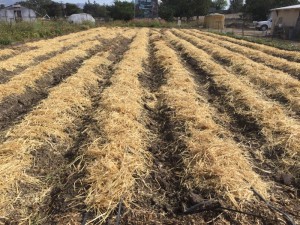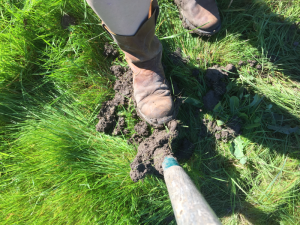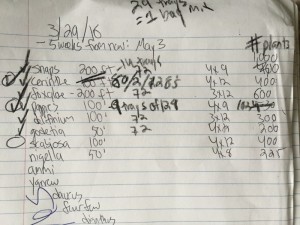Here on the Grab N’ Grow blog we want to help you avoid making the same gardening mistakes we have. Some would say the only real way to learn life’s lessons is to go down the wrong road, fully experience the consequences, and then adjust accordingly. But I say nay! Read on for some silly things I’ve done in the garden and fields, and you’ll be equipped with a road map for more success this season.
Spring Gardening Mistakes: Don’t Skip the Mulch
As we know, there are many reasons to mulch around plants and gardens. Mulch prevents weeds, it retains moisture, it keeps the soil cool, and it can help create a thriving soil microbial ecosystem as it slowly breaks down.
The goal is to mulch as soon as you plant. Just yesterday I planted four hydrangeas that are the first of many more to come. The hydrangeas are planted just below a short fence where they’ll get some shade, and have ample space in front of them for other, shorter shade-loving plants. My plan was just to get a few in the ground and come back later to plant the rest. BUT I know myself. I know this area will sit there, untouched, for months until I next get some spare time to finish it. And what will happen? Weeds, a bare soil surface that quickly loses moisture to the air, and lonesome unprotected plants left to blend in and get stepped on. Even though the area is not finished, I realized it’s in my best interest to mulch it now, either with a 4” layer of straw or wood chips. This way the soil is protected, spring weeds will be kept at bay, and all I have to do is rake back the mulch and plant more when I have time.

Spring Gardening Mistakes: Deal with Gophers NOW
As I learned from Thomas Whitman of Gophers Limited, these little critters are actively breeding in the spring. A reasonably small amount of effort now spent trapping just a few gophers will save you hours of work and tears a few months down the road should you wait for them to have babies that run rampant in your garden.
Not everyone traps gophers, and not everyone has to. For me, as I’m making a living off of my crops, it’s an absolute necessity. Sure there is gardening lore that speaks of other, less harmful ways of keeping gophers out of gardens, and I’m sure some of them work for some people. But for me to have assurance that the crops I plant will grow and produce to their full capability, I trap. This year I vow to make a big push to follow gopher tunnels and set a lot of traps in the spring – or else I’ll be faced with a disaster like I faced last August (read: tunnels heading every which way, evidence of gopher takeover). I highly recommend you read through Thomas’ site and watch his videos – there’s a lot to learn.
Spring Gardening Mistakes: Don’t Ignore Your Soil Moisture
I’ve made this point before but it bears repeating: wait for your soil to dry out before working it! Soil is fragile. If you treat it with care and patience, you will be rewarded with towering, healthy crops. Many of us get carried away with external factors – unseasonal, sunny weather, free time to get in the garden, a spring plant sale that comes too early. But it is well worth your time to pay attention to what is going on in your ground, and get in there to work the soil only when it’s at a near-perfect moisture level.
The main reason for this lies in the precious air space in your soil. When it gets muddy and heavy, your footsteps, hands, and digging tools will only act to squish out that air space – leaving no room for roots to spread and grow. Conversely, if your soil is too dry and you work it, you run the risk of breaking up aggregates that have formed, and turning your once-chunky tilth into dust.
To test if your soil is right for working, grab a handful of it, squeeze it into a ball, release your fingers, and see if the ball shape remains. If it quickly turned into a solid mass, it’s still too wet!

If it forms a loose ball, that easily breaks apart when you toss it lightly in the air and catch it again, it’s perfect and ready to be planted. Aim for this sweet spot for any of your gardening tasks – whether digging or transplanting. Otherwise, wait and avoid one of the most common gardening mistakes out there.
Spring Gardening Mistakes: Beat the Heat
As I write this, it’s unseasonably warm in Sebastopol. I kept a careful eye on the weather and knew the temperature would reach almost 90°. Now, I have lots of cold-hearty, tender annual flowers in the ground – anemones, ranunculus, and poppies, to name a few – and these guys really don’t like the heat. It’s my role as the farmer to extend their life and blooms as long as possible, even in the face of this crazy heat. So, the best thing to do would have been to get out there last night and water them up to be fully hydrated and ready to withstand the intense day. The second option was to get out there as early as possible this morning – at least earlier than the heat was scheduled to set in, and give them a good, deep watering. When in doubt, over water on days like this. The key point is to do it before the plants really need it. Had I waited til they were already droopy and dehydrated, they may never have recovered fully. As with everything in a sustainable garden system, take preventative measures as much as possible.
Spring Gardening Mistakes: Make a Note of That
As you begin your gardening season, think about really trying to record everything you do. What varieties are you planting? What date did you get them in the ground? How close together did you plant them? Did they look healthy from the start?
Other important things to note as the season progresses are: any problems such as bugs or diseases that the plants had to deal with, what your favorite varieties were, how often you watered and how deeply, the first date the plant started producing flowers and/or fruit, and the last date it produced. Your best information will come from your gardening journal. Start one now to better plan your garden in subsequent years.

Spring Gardening Mistakes: Overplanting and Overcrowding
Before you plant, think about how many cucumbers (or lettuce or onions) you and your family can really eat. Does it make sense to plant 5 tomato plants if it’s just you eating them? Unless you plan to make sauce to last you all winter, probably not. Read plant labels and seed packets, do your research, consult your garden journal from last year, and plant just enough of each crop.
Equally important is thinking about how close to place plants together in the garden. Again, read your labels, or check out these growing guides for specific crops. If you learn that a cucumber plant will grow to be 3′ around, then take that information to heart and leave 3′ between each tiny transplant as you put them in the ground. Planting too close together can increase disease, diminish yields, and lead to a crazy, unmanageable garden.
The key theme here is that we all spend a lot of time, money and prayers on our gardens. So it’s worth it to be patient, take the time to create systems and finish projects thoroughly, and above all, pay attention to the needs of your soil and plants.
Next time on the blog we’ll be jumping into this season’s Grow Your Own series with one of my favorite crops: asian greens. Stay tuned!







 Family
Family

